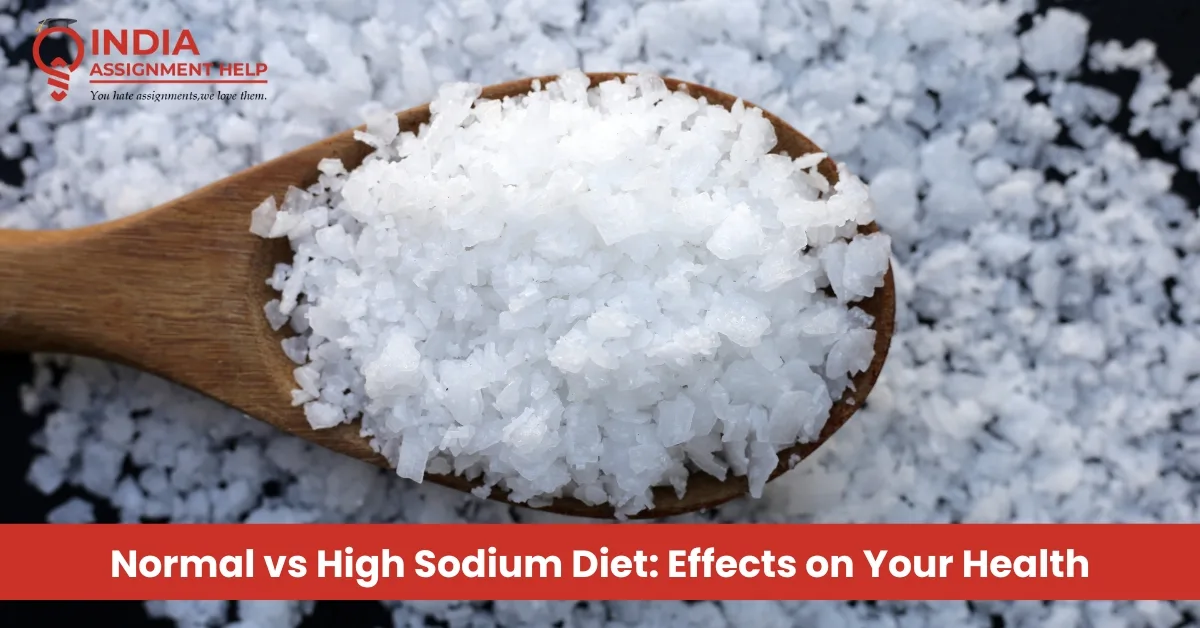Normal vs High Sodium Diet: Health Effects

Are you struggling to understand the fine line between a regular amount of sodium and a dangerously high intake? In a world where processed foods are prevalent, keeping track of your salt consumption can feel like a daunting task. For students, especially those balancing academics with personal life, making informed dietary choices is crucial for maintaining energy and focus. At India Assignment Help, we understand the importance of good health for academic success. This informational blog post will break down the essential differences between a normal vs a high-sodium diet, explore the serious health implications, and offer practical advice for a healthier lifestyle, all explained in very easy English.
What is Sodium and Why Do We Need It?
Sodium is a vital nutrient that plays several essential roles in your body. It helps maintain the balance of fluids in and around your cells, is critical for nerve function, and is necessary for muscle contraction. While the body requires sodium to function correctly, the key is moderation.
The main source of sodium in the diet is salt (sodium chloride). Unfortunately, most of the sodium we consume doesn't come from the salt shaker but is hidden in processed and restaurant foods.
Recommended Sodium Intake for Adults
What exactly is a "normal" amount? The recommended sodium intake for adults by major health organizations, such as the American Heart Association (AHA) and the World Health Organization (WHO), is generally quite low:
- Ideal Limit: For most adults, especially those with high blood pressure, the ideal limit is no more than 1,500 mg per day.
- General Maximum: A safe upper limit is usually 2,300 mg per day (about one teaspoon of salt).
To put this in perspective, an average single slice of pizza or a can of soup can easily contain 500-800 mg of sodium, making it very easy to exceed the recommended daily allowance.
The Danger Zone: High Sodium Diet and Hypertension
When you consistently consume a high-sodium diet, the consequences can be severe. The most significant health concern is its direct link to high blood pressure, medically known as hypertension.
The Role of Salt in High Blood Pressure
When you have a high-sodium diet, your body tries to flush out the excess sodium by holding onto extra water. This increases the volume of blood circulating through your blood vessels. Imagine pouring more water into a hose; the pressure inside increases. This increased volume puts greater pressure on your artery walls, leading to high blood pressure. This effect is why we talk so much about the role of salt in high blood pressure.
Sodium Intake and Hypertension
The correlation between sodium intake and hypertension is well-established. Over time, high blood pressure can damage your blood vessels and vital organs, dramatically increasing your risk for serious health issues like:
- Heart attack
- Stroke
- Heart failure
- Kidney disease
A persistently high sodium diet and hypertension are a dangerous pair, making it vital to manage your intake, especially if you have a family history of heart disease.
The Science Explained: Effect of Sodium on Blood Pressure
Understanding the mechanism behind the effect of sodium on blood pressure can be motivating. When you consume too much sodium, your kidneys, which are responsible for balancing fluid and electrolyte levels, struggle to keep up.
- Water Retention: Sodium draws water into your blood vessels.
- Increased Volume: The higher volume of blood requires more force to be pumped by the heart.
- Vascular Stiffness: Over time, the constant high pressure can cause the walls of your arteries to thicken and stiffen, which further elevates blood pressure.
This cycle highlights why switching from a normal to a high-sodium diet is one of the most effective ways to lower your blood pressure.
Switching to a Low Sodium Diet: Benefits and Practical Tips
The good news is that reducing your sodium intake can have a swift and positive impact on your health. The low-sodium diet benefits are extensive, including:
- Lowering or preventing high blood pressure.
- Reducing the risk of heart disease and stroke.
- Decreasing fluid retention and bloating.
Hypertension Management Diet
For those already dealing with elevated blood pressure, a specialized Hypertension management diet is often recommended. The most popular and effective is the DASH (Dietary Approaches to Stop Hypertension) diet.
The DASH diet is rich in:
- Fruits and vegetables (high in potassium and magnesium, which counteract sodium).
- Whole grains.
- Lean proteins.
- Low-fat dairy.
It actively limits foods high in saturated fat, cholesterol, and, most importantly, sodium. This diet plan is a sustainable way to manage your blood pressure without heavy reliance on medication.
Hypertension Diet Plan: Practical Steps
Implementing a comprehensive Hypertension diet plan requires small, consistent changes:
- Read Labels: Always check the "Nutrition Facts" panel for the sodium content. Look for "low sodium," "very low sodium," or "no salt added" labels.
- Cook at Home: Restaurant and take-out meals are primary sources of a high-sodium diet. Cooking your own meals gives you complete control over the salt content.
- Use Herbs and Spices: Replace salt with flavourful herbs and spices like garlic, ginger, lemon juice, pepper, oregano, and chili powder. Your taste buds will adapt quickly!
- Rinse Canned Foods: Rinsing canned beans and vegetables can remove a significant amount of the sodium solution they are packed in.
Academic Success and Your Diet
For students using resources like India Assignment Help for academic support, it’s easy to overlook health in the rush of deadlines. However, a diet high in sodium, which is often found in fast food and instant meals, can lead to sluggishness, poor concentration, and long-term health risks. A shift from a normal to a high-sodium diet is an investment in your well-being that pays off in sharper focus and better academic performance.
Remember, achieving a healthy intake is not about eliminating all salt, which is unrealistic and unnecessary. It's about moderation and moving away from a chronically high sodium diet.
Final Thoughts: Making the Change
Understanding the connection between sodium intake and hypertension is the first step toward a healthier lifestyle. The benefits of transitioning to a lower-sodium diet, guided by the recommended sodium intake for adults, far outweigh the short-lived satisfaction of overly salty foods.
If you are concerned about your blood pressure or sodium levels, consult a healthcare professional. They can help you create a personalized Hypertension diet plan that works for you. Take control of your health today, your body and your academic performance will thank you! The choice between a normal vs a high-sodium diet is clear: choose health.





